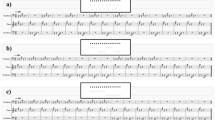Abstract
Many animal signals are performed in a highly redundant manner as in some bird species where males sing several renditions of one song type before switching to another. However, differences in signal redundancy between contexts and between individuals are only poorly understood. We found that chaffinches (Fringilla coelebs) in noisier areas (i.e., close to waterfalls and torrents) sang longer bouts of the same song type before switching to a new type, suggesting that they use increased serial redundancy to get the message across in noisy conditions. This is the first evidence of a noise-dependent adjustment of signal redundancy in a songbird. In addition, we found that song types with faster trills were sung in shorter bouts suggesting that the performance of highly redundant song series is probably limited by motor constraints. Thus, in noisy environments, serial redundancy in bird song may reflect a trade-off between successful signal transmission and preventing motor fatigue.





Similar content being viewed by others
References
Aubin T, Jouventin P (2002) Localisation of an acoustic signal in a noisy environment: the display call of the king penguin Aptenodytes patagonicus. J Exp Biol 205:3793–3798
Baptista LF (1975) Song dialects and demes in sedentary populations of the white-crowned sparrow (Zonotrichia leucophrys nuttalli). Univ Calif Publ Zool 105:1–52
Bradbury JW, Vehrencamp SL (1998) Principles of animal communication. Sinauer Associates, Sunderland
Brumm H (2004) The impact of environmental noise on song amplitude in a territorial bird. J Anim Ecol 73:434–440
Brumm H, Slabbekoorn H (2005) Acoustic communication in noise. Adv Study Behav 35:151–209
Brumm H, Todt D (2002) Noise-dependent song amplitude regulation in a territorial songbird. Anim Behav 63:891–897
Brumm H, Voß K, Köllmer I, Todt D (2004) Acoustic communication in noise: regulation of call characteristics in a New World monkey. J Exp Biol 207:443–448
Catchpole CK, Slater PJB (1995) Bird song: biological themes and variations. Univ. Press, Cambridge
Cynx J, Lewis R, Tavel B, Tse H (1998) Amplitude regulation of vocalizations in noise by a songbird, Taeniopygia guttata. Anim Behav 56:107–113
Cody ML, Brown JH (1969) Song asynchrony in neighbouring bird species. Nature 222:778–780
Ficken RW, Ficken MS, Hailman JP (1974) Temporal pattern shifts to avoid acoustic interference in singing birds. Science 183:762–763
Hinde RA (1958) Alternative motor patterns in chaffinch song. Anim Behav 6:211–218
Kroodsma DE, Miller EH (1996) Ecology and evolution of acoustic communication in birds. Cornell Univ. Press, Ithaca
Lachlan RF, Slater PJB (2003) Song learning by chaffinches: how accurate, and from where? Anim Behav 65:957–969
Lambrechts M, Dhondt AA (1988) The anti-exhaustion hypothesis: a new hypothesis to explain song performance and song switching in the great tit. Anim Behav 36:327–334
Lengagne T, Aubin T, Lauga J, Jouventin P (1999) How do king penguins (Aptenodytes patagonicus) apply the mathematical theory of information to communicate in windy conditions? Proc R Soc Lond B Biol Sci 266:1623–1628
Langemann U, Klump GM (2005) Perception and acoustic communication networks. In: McGregor P (ed) Animal communication networks. Cambridge Univ. Press, Cambridge pp 451–480
Leitão A, van Dooren TJM, Riebel K (2004) Temporal variation in chaffinch Fringilla coelebs song: interrelations between the trill and flourish. J Avian Biol 35:199–203
Leonard ML, Horn AG (2005) Ambient noise and the design of begging signals. Proc R Soc Lond B Biol Sci 272:651–656
Marler P, Slabbekoorn H (2004) Nature’s music: the science of birdsong. Elsevier, Academic, San Diego
Podos J (1996) Motor constraints on vocal development in a songbird. Anim Behav 51:1061–1070
Podos J (1997) A performance constraint on the evolution of trilled vocalizations in a songbird family (Passeriformes: Emberizidae). Evolution 51:537–551
Poesel A, Kempenaers B (2000) When a bird is tired from singing: a study of drift during the dawn chorus. Etología 8:1–7
Potash LM (1972) A signal detection problem and possible solution in Japanese quail (Coturnix coturnix japonica). Anim Behav 20:192–195
Riebel K, Slater PJB (1999) Do male chaffinches Fringilla coelebs copy song sequencing and bout length from their tutors? Ibis 141:680–686
Riebel K, Slater PJB (2000) Testing the flexibility of song type bout duration in the chaffinch, Fringilla coelebs. Anim Behav 59:1135–1142
Riebel K, Slater PJB (2002) Temporal variation in male chaffinch song depends on the singer and the song type. Behavior 140:269–288
Shannon CE, Weaver W (1949) The mathematical theory of communication. Illinois Univ. Press, Urbana
Slabbekoorn H, Peet M (2003) Birds sing at a higher pitch in urban noise. Nature 424:267
Slater PJB (1981) Chaffinch song repertoires: observations, experiments and a discussion of their significance. Z Tierpsychol 56:1–24
Slater PJB (1983) Sequences of song in chaffinches. Anim Behav 31:272–281
Vallet E, Kreutzer M (1995) Female canaries are sexually responsive to special song phrases. Anim Behav 49:1603–1610
Vallet E, Beme I, Kreutzer M (1998) Two-note syllables in canary songs elicit high levels of sexual display. Anim Behav 55:291–297
Wiley RH (1983) The evolution of communication: information and manipulation. In: Halliday TR, Slater PJBS (eds) Animal behaviour, vol 2. Blackwell Scientific Publications, Oxford, pp 156–189 (communication)
Wiley RH (1994) Errors, exaggeration, and deception in animal communication. In: Real L (ed) Behavioral mechanisms in ecology. University of Chicago Press, Chicago, pp 157–189
Acknowledgements
We would like to thank Katharina Riebel, Ole Larsen, Jeff Podos, and two anonymous referees for helpful comments on the manuscript. H. B. acknowledges funding by the Emmy Noether Programme of the German Research Foundation (award BR 2309/2-1) and the support of the Wissenschaftskolleg zu Berlin where a fellowship in the academic year 2004–2005 provided excellent working conditions.
Author information
Authors and Affiliations
Corresponding author
Additional information
Communicated by J. Podos
Rights and permissions
About this article
Cite this article
Brumm, H., Slater, P.J.B. Ambient noise, motor fatigue, and serial redundancy in chaffinch song. Behav Ecol Sociobiol 60, 475–481 (2006). https://doi.org/10.1007/s00265-006-0188-y
Received:
Revised:
Accepted:
Published:
Issue Date:
DOI: https://doi.org/10.1007/s00265-006-0188-y




